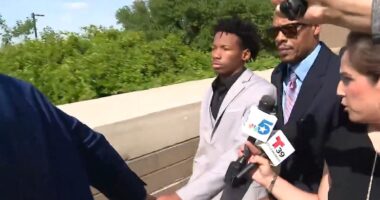A crash reconstructionist returned to the stand Wednesday in Karen Read’s second murder.
Read is facing allegations of causing the death of her boyfriend, John O’Keefe, a Boston police officer, by striking him with her Lexus SUV. She is currently undergoing trial at the Norfolk Superior Court in Massachusetts.
During the trial, crash reconstruction specialist Judson Welcher was questioned by Read’s defense team regarding his analysis of the incidents leading to O’Keefe’s passing in January 2022. Welcher’s assessment was based on information extracted from Read’s SUV, O’Keefe’s mobile phone, and evidence collected from the crime scene.
On Tuesday, defense lawyer Robert Alessi raised an objection when Welcher asserted, with a high level of scientific assurance, that Read had collided with O’Keefe using her vehicle. Alessi contended that such a claim could potentially influence the jury’s responsibility to form their own conclusions in the matter, as reported by USA Today.
As CrimeOnline previously reported, prosecutors said that Read intentionally ran over O’Keefe during a drunken outburst and then abandoned him to die in the snow outside the Canyon home of police officer, Brian Albert.
The prosecution introduced evidence of an admission that Read allegedly made the morning O’Keefe’s body was discovered, along with damage found on her vehicle and a timeline placing Read at the crime scene.
However, Read maintained that the crash never occurred and claimed she had been framed for O’Keefe’s murder. She reportedly said that fellow police officers beat O’Keefe inside Albert’s home before he was attacked by a dog.
Alessi focused on Welcher’s examination of scientific studies regarding bodily harm resulting from car collisions. Welcher told jurors that the studies he examined indicated that brain trauma is the most frequent injury resulting from car accidents. Alessi argued that one of the studies Welcher cited was over 45 years old.
Alessi also questioned the validity of Welcher’s experiments to determine whether Read’s vehicles caused O’Keefe’s injuries.
He argued that Welcher overlooked a roughly 4-inch berm on the lawn where O’Keefe’s body was found, stating that this berm would have altered O’Keefe’s position to the vehicle.
Welcher acknowledged he could not accurately say how O’Keefe was injured due to uncertainty about his exact position.
He pointed out that data from Read’s vehicle, however, indicated her tires spun for several seconds during her backup maneuver, suggesting this might have occurred as the car went over the berm.
The judge ruled Wednesday morning to exclude Welcher’s conclusion that Read struck O’Keefe with her vehicle from the testimony.
She stated that her concern was that Welcher had drawn “an inference based on more than scientific method.”
The trial continues. Check back for updates.
















